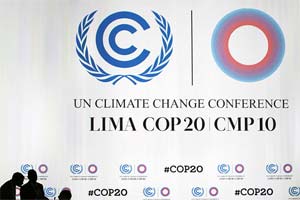The Lima climate talks finally produced an agreement, but only just. After protracted negotiations that continued into the morning of Sunday, almost 36 hours after its scheduled close on Friday, the over 190 countries at the conference grudgingly agreed on a minimalist text that some climate advocacy groups described as “disastrously weak”.
Most of what Lima was supposed to deliver on has been put off for the time being with the hope that they would get decided in the run-up to and during the next climate change conference, in Paris in 2015.
India said it was satisfied with the final outcome as most of its interests had been protected.
“The final text addresses almost all our concerns. We got what we wanted,” environment minister Prakash Javadekar said.
“This is not the best text that we could have had. But it is certainly the best that we could have secured in the circumstances. Of course, we have to act aggressively on climate change within our own country and the Narendra Modi government is doing exactly that,” Javadekar said.
The conference in Lima was supposed to deliver two things.
It had to decide on the kind of actions that countries must take in order to claim them as their “contributions” in the global fight against climate change.
These ‘contributions’, the magnitude of which were to be determined by the country itself, and hence called Intended Nationally-Determined Contributions, or INDCs, are to become the backbone of a new international legal architecture on climate change that are supposed to be finalised at the Paris conference next year. The international climate architecture, if agreed in Paris, would come into effect in 2020.
In addition, the Lima conference was also supposed to suggest the other features of this international legal architecture on which countries could negotiate and come to an agreement in Paris. In other words, it had to prepare the contours of a draft negotiating text for Paris.
On both these counts, the Lima Call for Climate Action, as the final outcome is being called, delivered little. The draft negotiating text has been left blank, and an agreement on what exactly should be counted as “contributions” in INDCs could not be reached. Developing countries had been fighting to include adaptation measures as well in the INDCs while the developed countries were insisting that only emission-reducing actions should be counted.
As a result the non-agreement, countries will be free to present their INDCs next year in the manner they want. Some countries would present only mitigation actions while others may include adaptation as well. Still others have insisted that they would also include money and technology they need to take climate action.
But the absence of finality on the INDCs was not the only problem with the agreement reached in Lima. It barely addresses the issue of increasing the ambition of emission cuts by developed countries prior to 2020, when the new agreement will come into effect, and ensuring loss and damage compensation for poor and vulnerable countries that get affected by extreme climate events.
But the most dangerous part of the agreement, according to several climate groups present at the conference, was the one relating to Common But Differentiated Responsibilities (CBDR), a basic principle enshrined in the UN Framework Convention on Climate Change (UNFCC) that allows developing countries to be treated differently, and lightly, from rich and industrialised countries on matters related to climate action.
While India said it was happy that CBDR had found an explicit mention — it was absent in an earlier version of the text — climate groups said the addition of the phrase “in light of different national circumstances” to CBDR severely diluted the principle. The additional phrase has been a direct lift from a recent agreement between the US and China, and has the potential to weaken the divide between developed and developing countries as and when “national circumstances” are perceived to have been changed.
“This totally compromises the position of developing countries. Differentiation is at the heart of climate negotiations. Developing countries might have to repent for letting this clause pass,” said Harjeet Singh, International Manager for Climate Change and Resilience at ActionAid International.
The European Union and the United States welcomed the Lima outcome as did many of the other countries.
“Although the EU wanted a more ambitious outcome from Lima, we believe that we are on track to agree a global deal in Paris next year,” said Miguel Arias Canete, EU Commissioner for Climate Action and Energy.
Climate advocacy groups were almost unanimous in describing the agreement as “weak” and “unjust”. A group of about 50 activists protested outside the plenary hall just as negotiators started walking in for the final meeting and shouted “No justice, No deal”.
“The year before the Kyoto Agreement was signed in 1997, the climate conference had collapsed. May be we needed a collapse here as well in order to get a good final legal agreement in Paris next year,” said Siddharth Pathak of Climate Action Network.


